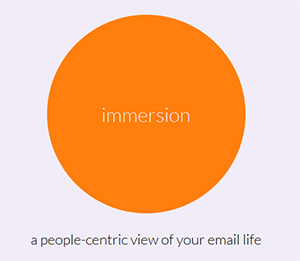 If you and gmail go back a ways, MIT have created a very interesting online tool. Immersion can show you who you communicated with, at what times, who introduced you to whom and how your various contacts are interrelated. Data is displayed as a web of connections, and clicking on the individual nodes/people drills down into their specific statistics. MIT do not scrape your email content, just the from, to, CC and timestamp fields, and that seems to be enough to generate some fascinating information.
If you and gmail go back a ways, MIT have created a very interesting online tool. Immersion can show you who you communicated with, at what times, who introduced you to whom and how your various contacts are interrelated. Data is displayed as a web of connections, and clicking on the individual nodes/people drills down into their specific statistics. MIT do not scrape your email content, just the from, to, CC and timestamp fields, and that seems to be enough to generate some fascinating information.
Switch Your Email Painlessly
If you've fallen out of love with your email client and want to try another service, TrueSwitch might be of interest. TrueSwitch automatically informs everyone in your contacts of your changed address, then forwards all of your email and contact data to your new account. Transfers between services partnering with TrueSwitch is free (Gmail, AOL and Outlook). For everyone else, a fairly reasonable $29.95. So, if you are one of the "90% of users [who] consider email interruption a barrier to switching to an ISP of their choice", procrastinate no longer.
Making email work for you
 If you use email, you know how much spam rubbish and general clutter floods into your inbox. Some estimates place the amount of unwanted email traffic at 95% (fortunately most of it is filtered out before it afflicts you). Yet despite this white noise, email is still one of the most powerful marketing channels, social media notwithstanding. Most people still maintain an email address, and most still read their email. If you have clients and potential clients you'd like to reach, email is a very good place to start. But beside coming up with attractive, interesting content, you will want your email communications to look professional, and you will need to track the metrics of your various email campaigns. Vision6 and MailChimp offer users a low cost and easy-to-use entry to the world of email marketing. MailChimp in particular offers an absurdly generous free service to users generating less than 12,000 emails per month. Plus they have a cute monkey avatar that dispenses cheerful backchat.
If you use email, you know how much spam rubbish and general clutter floods into your inbox. Some estimates place the amount of unwanted email traffic at 95% (fortunately most of it is filtered out before it afflicts you). Yet despite this white noise, email is still one of the most powerful marketing channels, social media notwithstanding. Most people still maintain an email address, and most still read their email. If you have clients and potential clients you'd like to reach, email is a very good place to start. But beside coming up with attractive, interesting content, you will want your email communications to look professional, and you will need to track the metrics of your various email campaigns. Vision6 and MailChimp offer users a low cost and easy-to-use entry to the world of email marketing. MailChimp in particular offers an absurdly generous free service to users generating less than 12,000 emails per month. Plus they have a cute monkey avatar that dispenses cheerful backchat.
